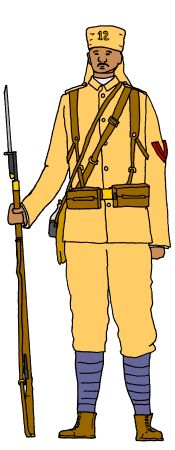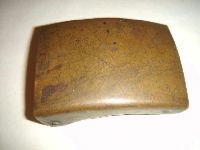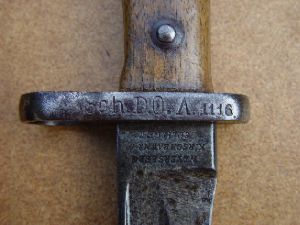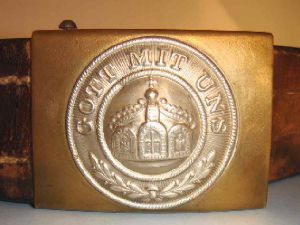|
Uniform Evolution of the Wissmanntruppe, Schutztruppe and Polizeitruppe
Askaris in the early 1890s
Soon after the initial formation of the
Wissmanntruppe several
changes were made to the uniforms of the askaris. Gradually the differences between the uniforms of
Sudanese, Zulu and Swahili askaris began to disappear. The coloured naval
style uniforms of the Zulus and Swahilis were abandoned as were the
Sudanese turbans. The transition between uniforms was not however a smooth
one, and mixtures of old and new uniforms along with variations of details
on the new uniforms can often be seen in photographs of this period. The Wissmanntruppe were renamed the
Schutztruppe for East Africa in 1891 and the following year the
Polizeitruppe were formed. By the mid-1890s uniforms for askaris were
standardised (See Schutztruppe
Askaris and Polizeitruppe Askaris).
Khaki Uniform
Askaris of all nationalities now wore a khaki uniform based on that of the
original Sudanese askaris in Anglo-Egyptian army. It had five a stand and fall collar, plain shoulder straps, plain cuffs, no
pockets and five brass buttons fastening the front. Variations on the
khaki tunic did still exist around this time, with some tunics having at
least one breast pocket while some illustrations of the period show large
yellow company numbers being worn on the upper left arm, although no
photographic proof of this has so far been seen. Likewise the buttons of
the Wissmanntruppe askaris were brass while later askari buttons were
white metal. It is probable that both were worn during this transitional
phase.
Trousers were matching
khaki and dark blue/grey puttees with brown leather boots
introduced for all askaris. The Germans experimented with the
suitability of askaris having bare feet, sandals and boots.
They came to the conclusion that while they were uncomfortable for some
soldiers, boots gave the best protection against parasites and were
therefore usually insisted upon by their officers. Some photographs do
however show askaris without footwear.
White Uniform
One short lived uniform introduced in
about 1891 was the white askari parade uniform. It consisted of a white
tunic with a small standing collar along the lower edge of which was
band of braid in the imperial colours. The tunic had plain cuffs, no
shoulder straps, no pockets and five buttons fastening the front. It was
issued with matching white trousers and was probably not intended for
use on active service.
Headdress
The red fez with a blue/black tassel was adopted by all askaris and
a new style of headgear, the Tarbush was also issued. The tarbush
eventually replaced the red fez on active service and was made of a
peakless wicker frame with a khaki cloth cover and neckshade. The first
tarbushes were worn without insignia, for a short time a loop of red
lace was worn on the tarbush and later company numbers were displayed
brass.
See further down the page for full information on the
Evolution of
Schutztruppe Askari Headdress
in the 1890's
Rank Insignia
Askari NCOs wore one to four inverted chevrons to display their rank
(see NCO Rank
Insignia Page). East African askaris used Ottoman NCO titles, another
tradition dating back to the previous service of many Sudanese askaris
in the Anglo-Egyptian army. Their
titles were- Ombasha/Gefrieter (with one stripe), Schausch/Unteroffizier (with
two stripes), Bet-Schausch/Sergeant (with three stripes) and
Sol/Feldwebel (with four stripes). From 1890 the chevrons were
officially changed from blue to red, although it is possible that some
NCOs retained their old insignia. These red chevrons were usually worn
on the upper left arm, although little standardisation seems apparent in
period photographs with some NCOs wearing their chevrons on the lower or
right arms.
Equipment
Gradually the old single large ammunition
box began to be replaced by the newer 1871 ammunition pouches (see
Personal Equipment Page) which were carried
either side of a plain brass belt buckle, again simialr to that of the
Anglo-Egyptian army. Askaris would also have carried water bottles,
bread bags and blankets.
Weapons
The askaris
were armed with the single shot Mauser Jägerbüsche '71 rifle and the S71/84
bayonet. Bayonet knots were not worn by the askaris.
The Illustrations
Figure 1 is based on a
photograph of a Sudanese Askari NCO taken in about
1891. He is dressed typically for
askaris of this period in the khaki uniform with dark blue/grey puttees. His
headgear is the red felt fez still worn when not in action after the introduction of
the tarbush for active service, in fact the two are often seen worn side by side
in photographs of groups of askaris. In 1890 blue NCO rank
chevrons started to be replaced by red. The two
chevrons worn here on the upper left arm denote the rank of "Schausch" (Unteroffizier, or Corporal-
see NCO Rank Insignia Page). The chevrons
in the original photograph appear to have vertical edges. Later chevrons usually had horizontal
edges. From his second tunic button he has
what looks like a watch chain but may more likely be a signalling
whistle.
He is armed with an M79 Army
Revolver (a 10.6mm weapon commonly issued to the early Schutztruppe with
a distinctive long butt)
tucked into a brown leather belt with a plain brass belt buckle (see
below).
Figure 2 is based on a
photograph of a Zulu Askari taken in about 1891. He wears
the Sudanese style khaki uniform, now standard for all askaris with dark
blue/grey puttees and brown leather boots. His headgear is the newly introduced
Tarbush as described above. The first tarbushes were worn plain without any
decoration but one short lived variation seen in contemporary photographs and
illustrations shows the Tarbush worn with a loop of red cord on
the khaki cover.
This askari wears a medal ribbon on his left breast.
It is most likely the
Kriegerverdienstmedaille, instituted for East African askaris in 1892. The first
class award was a silver medal with the motto "KRIEGER VERDIENST" within a laurel wreath, on a black and white ribbon
similar to that of the Iron Cross. The second class was similar but with
a smaller medal. This askari wears only the ribbon of his award.
The equipment worn here is a
brown leather belt with an imperial belt buckle (see
below). These belt buckles were usually only worn by German
NCOs in the Schutztruppe, while askaris normally wore plain brass
buckles. He is armed with a Jägerbüsche 71 rifle and the handle of his
S71/84
bayonet (see below) can just be seen suspended from the left side of his belt.
Figure 3 is based on a
photograph of a Sudanese Askari in Police service taken in
1889. He wears the short-lived white parade uniform introduced in about 1890-91,
as described above. He also wears matching white
trousers, dark blue/grey puttees and brown leather boots. His headdress seems to be some from of loose turban. He is
armed with
a Jägerbüsche 71 rifle and his equipment consists of a single large box
ammunition pouch suspended on a brown leather belt.
Before the formation of the
Polizeitruppe in German East Africa police duties were performed by
members of the Wissmanntruppe or Schutztruppe. These police were usually
identified as seen here by a red sash worn over the right shoulder.
Figure 4 is based on
a photograph of a Zulu Askari NCO taken in about 1891. He wears a
variation on the usual askari khaki tunic with a single patch pocket
with a pointed flap on the left breast.
Above the pocket he wears a
medal, most likely the
Kriegerverdienstmedaille. As described above it consisted of a black and white
ribbon similar to that of the Iron Cross with a silver medal, in this
case for a 1st class award. The second class was similar but with
a smaller medal. Sudanese askaris
(and their NCOs and officers) were also still entitled to wear medals
earned in Anglo-Egyptian service prior to their enlistment in the
Wissmanntruppe in 1889.
This NCO's rank chevrons are unusually worn on the lower right
arm above a band in the imperial colours. This particular style of rank insignia
has only been seen in this one photograph. It seems that NCO rank
insignia was still not standardised between the different Schutztruppe
companies at this point. From his second button of his tunic he has
what looks like a watch chain but may again more likely be a signalling
whistle.
His headgear is the red fez
still worn when not in action after the introduction of the tarbush for
active service.
He wears dark
blue/grey puttees and brown leather boots. His equipment consists of a single large box
ammunition pouch suspended on a brown leather belt. In his right hand he carries
an NCOs baton or marching stick.
| |
Plantan Effendi
- was one of the original Zulu askaris recruited in Portuguese East
Africa for the Wissmanntruppe in 1889. He came from a large extended
family. One of his brothers was Lobengula, a Matabele chief, another
brother, Sykes Mbuwan (grandfather of the Tanzanian nationalist,
Abdulwahid Sykes) also enlisted in the Schutztruppe and was killed
fighting the Wahehe in 1894. Plantan himself served the Schutztruppe
well, converted to Islam, learned Arabic and was eventually promoted
to Effendi (African Officer). He was died in December 1914 after
25 years in German service.
Highly Recommend Reading - "Askari und Fitafita" by Thomas Morlang
(see Book Reviews Page) |
Figure 5 is based on
a photograph of a Sudanese Askari NCO, probably taken in
the mid to late 1890's. This askari is typical of the appearance
of Schutztruppe askaris once uniforms had standardised during the 1890's. He wears the
khaki tunic and trousers, dark blue/grey puttees, and brown leather
boots. The tarbush bears the company numeral in stylised brass letters
(in this case the 12. Feldkompagnie based in Mahenge) which
became the standard tarbush decoration in the mid-1890's.
His NCO rank insignia (again
the two stripes of the "Schausch"- see
NCO Rank Insignia Page) is worn in
the manner standardised amongst askaris during the early 1890s. These
red chevrons had horizontal edges and were worn on the upper left arm.
This NCO is armed with a
Jagerbusche 71 rifle with bayonet and carries full marching equipment
consisting of a brown leather backpack, folded blanket, bread bag and
water bottle as was also issued to the regular German army of the
period. The ammunition pouches are the 1871 design carried by most
askaris until the First World War.
| |
Schausch Imbarag Ali.
Few records were kept about the lives of individual askaris so it
is impossible to know much for certain about Imbarag Ali. From his name
and the scars on his cheek seen in the original photograph, one may deduce that he
was one of the original
Sudanese askaris recruited for the Wissmanntruppe in Cairo in 1889 and
may have risen
through the ranks after staying in German service after the Abushiri
Rebellion. These Sudanese askaris, veterans of Wissmann's campaigns,
were considered the elite of the Schutztruppe in East Africa. |
| |
|
|
The Evolution of
Schutztruppe Askari Headdress
in the 1890's |
 |
 |
 |
 |
 |
|
Figure A
Fez c1889-1918 |
Figure B
Tarbush c1890-1918 |
Figure C
Tarbush c1891 |
Figure D
Tarbush c1891-1900 |
Figure E
Tarbush c1896-1918 |
|
Figure A shows a red fez as
worn by all askaris when not on active service and occasionally by
some on active service. Similar fezzes had been traditionally worn
throughout the Ottoman Empire and North and East Africa for centuries.
It was first worn in German service by askaris of the German East
African Company in the late 1880's and was still in use with
Schutztruppe askaris throughout the First World War. The fez was made of red felt with a
knotted tassel and no insignia. From photographic evidence these
fezzes varied considerably in height, style and rigidity. The tassel
likewise varied in length but was usually black or dark blue/black.
When a second Zulu company was formed they were distinguished by the
use of a white tassel. This distinction was short lived and has not
been seen in photographs.Figure
B shows the Tarbush, a peakless wicker frame with a khaki cloth
cover and neckshade as originally worn
without insignia. The tarbush was originally introduced for Sudanese askaris
without insignia in about 1890-91. Later, even when the
company numerals and imperial eagle badges had been introduced they
were often not worn in action as they provided a good target for
enemy marksmen. When the badges were removed they left two
horizontally placed holes in the centre of the khaki cover where the badge
pin had been.
Figure C shows the tarbush
worn with a loop of red cord on the khaki cover. This tarbush
decoration appears to have been very short lived (around 1891). It has been suggested that different companies wore
different colour cords though this has not been proven.
Figure D shows the tarbush
worn with a stylised brass company numeral on the khaki cover. These
company numerals (in this case 7 for the 7. Feldkompagnie)
were introduced for Schutztruppe askaris around 1891. Although they
were officially replaced by the imperial eagle in 1896 some units
still wore the company numerals as late as 1900. Some sources state
that red or green cloth company numerals were also sometimes worn on the
tarbush although as yet no photographic proof has come to light.
Figure E shows the tarbush
worn with a white metal eagle on the khaki cover. The imperial eagle
badge was introduced in 1896 and gradually replaced the company numerals. A larger
brass eagle was worn by the Polizeitruppe askaris.

Askaris Preparing for an Expedition
c1891-96
The white uniform with with three
buttoned cuffs worn by the mounted German officer dates this photograph
from 1891 onwards. This uniform was phased out from 1896. The askaris
wear khaki uniforms with plain khaki tarbushes without company numbers
or eagles. Some appear to be wearing white covers on their tarbushes.
They carry full marching equipment some with blankets rolled over their
shoulders.
Photo ©
Frankfurt University Koloniales Bildarchiv

Askaris in Bukoba c1890
They wear the khaki uniform and the tarbush with white covers. They are
armed with carbines, possibly the Mauser Kar71. Rather than ammunition
pouches they carry bandoliers of rounds around their waists and over the
shoulder. They unit all appear to be bare footed.
Photo ©
Frankfurt University Koloniales Bildarchiv

Zulu Askaris of Ramsey's Company c1890
The askaris wear the khaki uniform. Some have the red fez, others the
khaki tarbush with a loop of red lace. Some of the askaris carry the
single large ammunition pouch. Several have Prussian medals for
campaigns in the Wissmanntruppe. The German officer carrying a sword on
the right is Leutnant Tom Prince (later Hauptmann von Prince, killed at
the Battle of Tanga in 1914).
Photo ©
Frankfurt University Koloniales Bildarchiv

Askaris Preparing for an Expedition c1891-96
The white uniform with yellow
metal crown buttons on the collar worn by the German officer dates
this photograph from 1891 onwards. This uniform was phased out from
1896. The askaris wear khaki uniforms with plain tarbushes without
company numbers or eagles. They carry full marching equipment with
blankets rolled over their shoulders.
Photo ©
Frankfurt University Koloniales Bildarchiv

Sudanese Askaris of the 1.
Feldkompagnie cMid 1890s
They wear the khaki uniform and tarbush with the 1889 ammunition
pouches. In front of the row of askaris is their African officer or
Effendi.
Photo ©
Frankfurt University Koloniales Bildarchiv

Askaris of the 11. Feldkompagnie cMid 1890s
They wear the khaki uniform with a khaki tarbush bearing their company
number as a yellow metal badge on the front. They carry full marching
equipment and 1889 ammunition pouches. Note the musician wearing
swallows nest insignia on his shoulders in the centre.
Photo by Becker
©
Frankfurt University Koloniales Bildarchiv
|
|
|
|


















